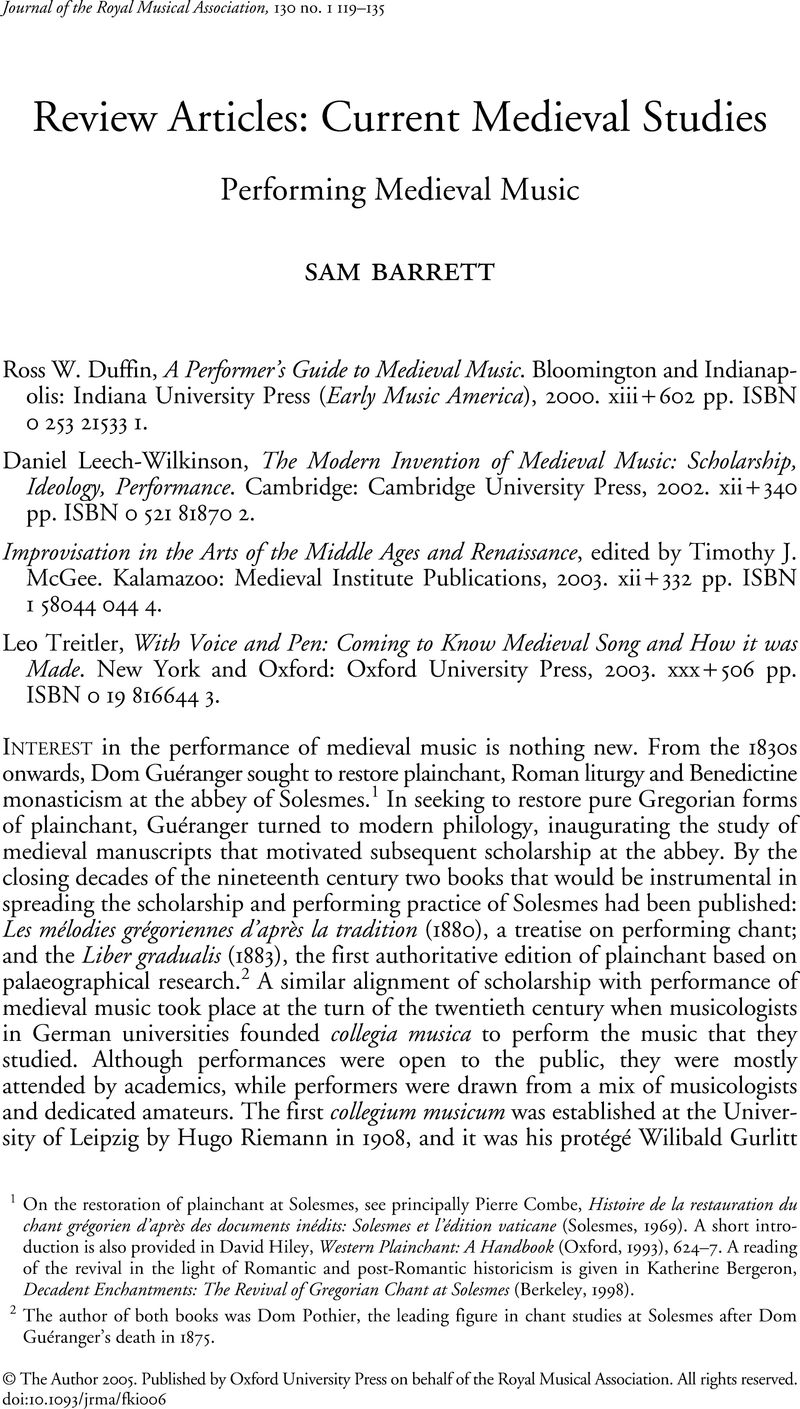No CrossRef data available.
Performing Medieval Music
Published online by Cambridge University Press: 01 January 2020

1 On the restoration of plainchant at Solesmes, see principally Pierre Combe, Histoire de la restauration du chant grégorien d'après des documents inédits: Solesmes et l'édition vaticane (Solesmes, 1969). A short introduction is also provided in David Hiley, Western Plainchant: A Handbook (Oxford, 1993), 624–7. A reading of the revival in the light of Romantic and post-Romantic historicism is given in Katherine Bergeron, Decadent Enchantments: The Revival of Gregorian Chant at Solesmes (Berkeley, 1998).Google Scholar
2 The author of both books was Dom Pothier, the leading figure in chant studies at Solesmes after Dom Guéranger's death in 1875.Google Scholar
3 Gurlitt's colloquium performed early chant through to chansons by Dufay and Binchois, beginning with three concerts in Karslruhe in 1922. On the spread of collegia musica, see Emil Platen and Iain Fenlon, ‘Collegium musicum §6. The 20th-Century Revival’, The New Grove Dictionary of Music and Musicians (2nd edn, London, 2001), vi, 119.Google Scholar
4 Thomson, John M., Early Music, 1 (1973), 1.Google Scholar
5 For Kerman's critique, see his Musicology (London, 1985), 182–217. Taruskin's contributions on the subject of authenticity are collected together in his Text and Act (Oxford, 1995).Google Scholar
6 Dust-jacket to Performance Practice: Music Before 1600, ed. Howard Mayer Brown and Stanley Sadie (London, 1989).Google Scholar
7 Ibid., x.Google Scholar
8 For a relatively early discussion of this relationship, see José Bowen, ‘Mendelssohn, Berlioz, and Wagner as Conductors: The Origins of the Ideal of “Fidelity to the Composer”‘, Historical Performance, 6 (1993), 77–88.Google Scholar
9 For an easily accessible overview of recent thinking in this domain alongside a call to orientate musicology towards performance studies, see Cook, Nicholas, ‘Between Process and Product: Music and/as Performance’, Music Theory Online, 7/2 (2001), at <www.societymusictheory.org>, the main themes of which are revisited in Nicholas Cook, ‘Music as Performance’, The Cultural Study of Music: A Critical Introduction, ed. Martin Clayton, Trevor Herbert and Richard Middleton (New York and London, 2003), 204–14.,+the+main+themes+of+which+are+revisited+in+Nicholas+Cook,+‘Music+as+Performance’,+The+Cultural+Study+of+Music:+A+Critical+Introduction,+ed.+Martin+Clayton,+Trevor+Herbert+and+Richard+Middleton+(New+York+and+London,+2003),+204–14.>Google Scholar
10 Two recent studies of medieval music that owe an explicit debt to new critical trends are Bruce Holsinger, Music, Body and Desire in Medieval Culture: Hildegard of Bingen to Chaucer (Stanford, 2001), and Emma Dillon, Medieval Music-Making and the ‘Roman de Fauvel‘ (Cambridge, 2002).Google Scholar
11 Peter Kivy, Authenticities (Ithaca, NY, 1995), 135.Google Scholar
12 ‘Authenticity …is knowing what you mean and whence comes that knowledge. And more than that even, authenticity is knowing what you are, and acting in accordance with that knowledge.’ Taruskin, ‘The Limits of Authenticity: A Contribution’, Text and Act, 67–82 (p. 67).Google Scholar
13 A classic consideration of the emergence of the idea of fixed musical structures during the Middle Ages is Fritz Reckow, “Processus” und “structura”: Über Gattungstradition und Formverständnis im Mittelalter’, Musiktheorie, 1 (1986), 5–29.Google Scholar
14 On musical performance as improvisation, see Cook, Nicholas, ‘Making Music Together, or Improvisation and its Others’, The Source: Challenging Jazz Criticism, 1 (2004), 5–25. For the wider argument that all musical activity is improvisatory, see Benson, Bruce Ellis, The Improvisation of Musical Dialogue: A Phenomenology of Music (Cambridge, 2003).Google Scholar
15 The oft-cited text at the centre of this movement is Stephen Greenblatt, Renaissance Self-Fashioning: From More to Shakespeare (Chicago, 1980).Google Scholar
16 A sharp analysis of the authorial voices present in Leech-Wilkinson's narrative is given in Jeremy Llewellyn's review in Early Music, 32 (2004), 135–8.Google Scholar
17 Paul Hamilton, Historicism (London, 1996), 2.Google Scholar
18 See, for example, Taruskin, ‘Last Thoughts First’, Text and Act, 24–30.Google Scholar
19 ‘In quo usque hodie, in cantu si quid dissentitur, quasi in speculo error eiusmodi universus corrigitur.‘ Ekkehard IV, Casus sancti Gallii, ed. Hans Haefele (Darmstadt, 1980), 108.Google Scholar